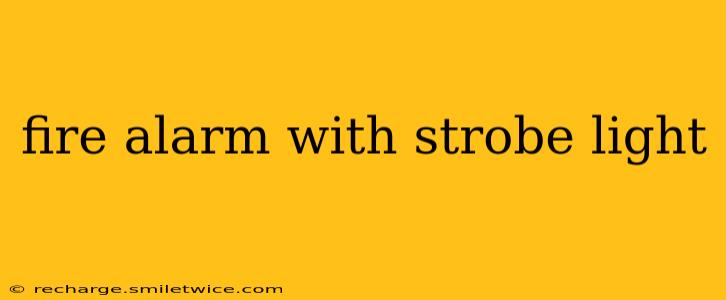Fire alarms save lives, and the addition of a strobe light significantly enhances their effectiveness, particularly for individuals with hearing impairments. This comprehensive guide explores the vital role of strobe lights in fire alarm systems, addressing common questions and providing valuable insights into their functionality and importance.
What is a Fire Alarm with a Strobe Light?
A fire alarm with a strobe light combines the familiar audible alarm with a visually alerting strobe (flashing light). The strobe light provides a secondary warning signal, ensuring that individuals who are deaf or hard of hearing, or those in environments with significant background noise, are alerted to a fire emergency. This dual-warning system significantly improves the overall safety and accessibility of fire protection. The strobe's flashing intensity and frequency are regulated to meet specific safety standards for optimal visibility and effectiveness.
How Does a Strobe Light in a Fire Alarm Work?
The strobe light is activated simultaneously with the audible alarm, triggered by the same smoke or heat detector. The intensity and frequency of the flashing light are carefully designed to penetrate even heavy smoke and grab attention effectively. These alarms often have a built-in sensor that detects the presence of smoke or fire, automatically initiating both the audible and visual alarms. Battery-powered systems provide backup power in case of a power outage. The strobe itself is a simple yet effective technology involving a rapidly flashing Xenon lamp or LED.
Why is a Strobe Light Important in a Fire Alarm System?
The inclusion of a strobe light significantly improves the safety of buildings, particularly for individuals who rely on visual cues. Here's why it's so critical:
- Accessibility for the Hearing Impaired: Strobe lights are essential for people with hearing loss, ensuring they receive timely warning of a fire, giving them precious seconds to escape.
- Enhanced Visibility in Noisy Environments: In settings with high ambient noise levels (factories, construction sites), the audible alarm can be easily missed. The strobe light cuts through the noise, providing a reliable visual alert.
- Improved Alerting in Smoke-Filled Conditions: Smoke obscures sound, muffling the audible alarm's effectiveness. The strobe's bright flashes are far less affected by smoke, ensuring the alarm remains visible.
- Increased Response Time: The combined visual and audible alarm ensures a faster response time, giving occupants more time to evacuate safely.
What are the Different Types of Fire Alarms with Strobe Lights?
Fire alarms incorporating strobe lights are available in various configurations to suit different needs and building types. These include:
- Standalone Smoke Detectors with Strobe: These devices combine smoke detection, an audible alarm, and a strobe light in a single unit.
- Integrated Systems: Larger buildings often utilize interconnected alarm systems where multiple detectors and alarms are linked. The strobe functionality is integrated into the overall system.
- Wireless Systems: These offer flexibility in placement and easy installation, often including strobe lights as part of the system.
How Often Should I Test My Fire Alarm with a Strobe Light?
Regular testing is paramount to ensuring your fire alarm, including the strobe light, functions correctly. Most authorities recommend testing your alarms monthly. This ensures that both the audible and visual alarms are working and that the batteries are still functioning.
Where Should I Install a Fire Alarm with a Strobe Light?
Strategic placement is crucial for maximizing the effectiveness of your fire alarm. Install units on ceilings and walls according to building codes and manufacturer instructions. Consider placing additional units in areas with potential high noise levels or where visibility may be impaired.
Are Fire Alarms with Strobe Lights Required by Law?
Building codes and regulations vary widely depending on location. However, many jurisdictions mandate fire alarms with strobe lights in certain settings, especially in buildings housing people with disabilities. It's crucial to check local fire codes and regulations to ensure compliance. Consult with local fire authorities or building inspectors to determine specific requirements for your area.
This guide provides a comprehensive overview of fire alarms with strobe lights. Remember, prioritizing safety and ensuring everyone in your building has a reliable warning system is paramount. Always consult with qualified professionals for installation and maintenance.
